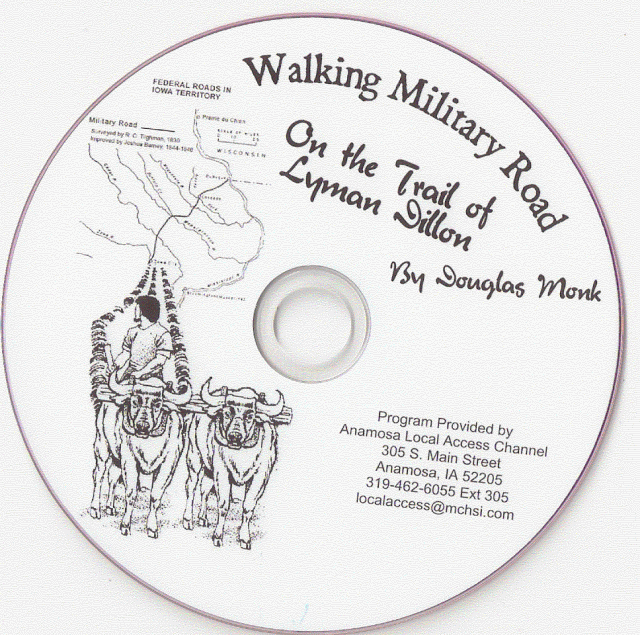

Here is the text from this article in case you have a hard time reading it (above):
Monticello man follows Dillon’s Furrow by Doug Lindner Solon Economist
Solon- In 1839, Iowa was on the edge of the western frontier.
Aside from a few Indian and game trails, there was nothing but virgin prairie.
That year, the U.S. Congress appropriated $20,000 for the construction of a military trail between the new capital, Iowa City, and the mining town of Dubuque. After the route was surveyed, Lyman Dillon of Cascade was hired to bust the sod for the road with a team of oxen and a breaking plow.
The military road eventually became Hwy 1, passing through Solon, Mt.Vernon and Monticello.
Last Spring, Monticello contractor Douglas Monk came upon an issue of The Palimpsest, a historic journal, in which two men retraced the original military trail in 1920.
The account inspired Monk, who had grown up not far from stretches of the old road, and he decided to take a walkabout along the trail, imagining the earthy origins of the area.
“That’s kind of the reason I was interested,” Monk said after his walk was completed. “It went right past my stomping grounds.”
Monk had been interested in the history of the region for several years, sparked by listening to the taped reminiscences of his grandfather. He searched the web for historical references to the Monticello area and found the article from The Palimpsest.
“My mind is always thinking of things I want to do in my life,” said the 50 yr -old father of four. “I’m intentional about ideas like that. This fit my list.”
Married 29 years and with his own construction business, Monk has composed two books of letters and intends to write another on his experience walking Lyman Dillon’s trail.
He began his journey on foot Monday September 8th (2008) from the former site of Butler’s Capital in Iowa City (about two blocks east of the Old Capital) and spent six days walking the 81 miles to Dubuque, where he arrived Saturday Sept.13th.
Most of the way, he followed Hwy 1 passing through Solon the afternoon of his first day. As he did in most of the towns, he visited with interested historical groups or classrooms, sharing his research and his observations.
In 1839, Iowa City wasn’t much of a town.
Butler’s Capital was the first building in which the legislative meetings were held. Monk said, but it doubled as a hotel and tavern. Dubuque was a small mining town. Monk said his research indicated the trail was military in name only, necessary for the congressional financing it received.
Lyman Dillon was paid $3.00 a mile to break the trail with 10 oxen and a large plow.
He also thinks Dillon probably had some help with the task.
“He followed the ridges for the most part,” Monk said. “That’s why (Highway) 151 snakes. It’s following the contour of the ground.”
Monk made no special preparations for the walk, and hadn’t been an avid walker prior to the trip, but suffered few ill effects from the journey.
The hardest portion came walking downhill into Anamosa while the most scenic, he noted, was outside of Dubuque going through Key West.
In a pasture near Langworthy, he found a part of the original road, a bridge with stonework still above ground. ‘Most of it’s under the road,” he noted (editor’s note: most of the original Old military road is under the new highways..where as this portion is still visible because it’s in a pasture on the Elenore Jacobs farm just East of Langworthy)
He also found Lyman Dillon’s tombstone in Cascade.
Dillon was 39 and single at the time he plowed the furrow, owner of a local saw mill. (in cascade)
Along the way, Monk imagined life in Iowa from 1839 to 1900, using accounts of Dillon’s furrow as a thread to follow the state’s history. There are lots of interesting stories he picked up along the route, including those shared by Raphael Pisarik during Monk’s overnight stay in Solon.
“There’s quite a bit of drama, ” he observed.
Enough for a book, “On The Trail Of Lyman Dillon” which Monk has already started. He’s still collecting stories, especially regarding Solon’s history.
You can find out more about Monk’s walk by visiting https://onthetrailoflymandillon.wordpress.com/







 \
\






